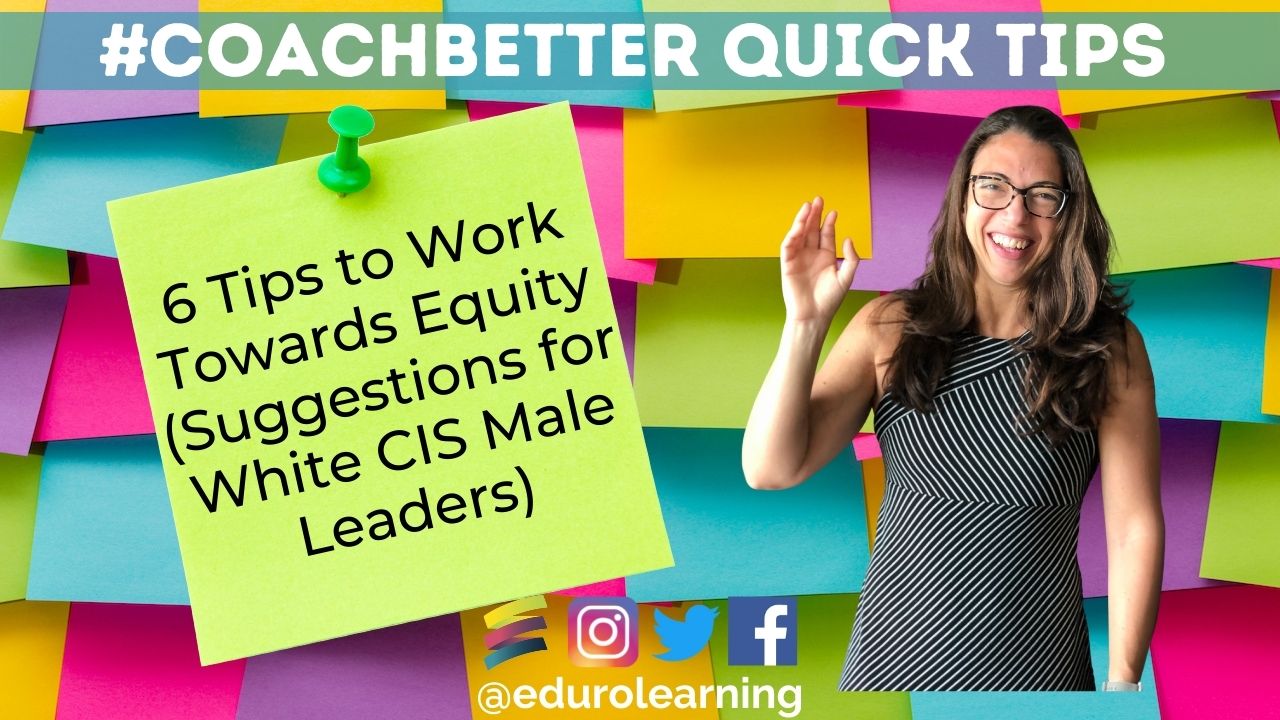Today’s post reflects some of the insights that I learned from conducting the Women Who Lead interviews. (Women Who Lead is our newest online certificate program designed for growing & aspiring leaders, featuring the voices and experience of over 70 successful female leaders from around the world).

Today’s post is also a little bit unique in terms of our usual content. The tips I’m sharing are actually designed for white male leaders who are looking for strategies to support equity in their organization. So this is something you might want to pass on to your leaders, or it’s something you might want to watch and digest, and then share the appropriate strategy with your school leader.
I’ve also tried to share them in a way that is palatable for school leaders who may not have thought about this in this light before. So the language I’m using here might be something you can just take and apply for your situation. While I’m sharing these six ways to take action for equity I’m speaking to white CIS male school leaders, so if that’s not you, please feel free to adjust and apply them as needed for your school context.
I know that lots of us are working in schools where we are trying to make a difference, and we are trying to make an impact and these are six concrete strategies that came up from the women who lead interviews that might be relevant for you and your school community. Hopefully they are helpful for you!
1: Don’t Center Yourself
This is not about how you feel, or what you need, or what you want to do. It’s about listening, providing space for others, and doing the work internally to shift your own mindset and deal with your internal biases. That may make it hard to be “visible” as a white-CIS-male supporting women and people of color. You will do that through your amplification of their voices, and the actions you take, rather than raising your own.
2: Amplify the Voice of Others
As an individual, you can start by amplifying the voices of those that are often unheard. Create space for others who may not have a forum to speak out, or an established audience to listen. Maybe this is giving space in your leaders newsletter to someone who doesn’t normally get an audience, featuring work in a staff meeting, or providing an opportunity for community stakeholders to hear an alternate perspective.
3: Speak Out
Along those lines, when you hear racist or sexist behavior, speak out. Among groups of men, during hiring practices, in meetings, whenever you see this behavior, call it out and clarify that it’s wrong. When men label racist and sexist behavior to other men, it makes a bigger impact that you might imagine. When women share their experiences with you, believe women. Find ways to amplify those voices to a level where action can be taken. Rationally state, again and again, what needs to change to create a more equitable environment.
4: Identify Aspiring Leaders
If there are women you see as potential leaders, give them a metaphorical “tap on the shoulder” to encourage them into leadership. That support from others is what prompted many of the Women Who Lead to start down a leadership pathway. Naming and sharing individual traits that tend towards leadership can be a huge eye opener, especially for women. When you take the time to notice, identify and articulate these traits you are helping women build the confidence they need to take that next step.
5: Do the Work
As a school leader, you can make it a priority to do equity work. You can start by learning on your own, to build your capacity for doing this work with others. You can provide opportunities for professional learning for your staff, your leaders, your extended school community. You can spend time building committees to create policies that are anti bias and antiracist. You can do this work with your board, and the parent community. You may want to hire an expert in this area to facilitate conversations, or you may have members of staff who can lead this work. Make time for it and make it available to everyone.
6: Put Policies in Place
As you build your understanding, and school wide capacity, set up practices that ensure unconscious bias doesn’t play a role in hiring (like blind CVs). Make it a point to hire people from a wider variety of backgrounds. If you look at the school’s website and the leadership team is exclusively white men, let that be a prompt for your thinking about the unconscious bias in your hiring practices. Overall, normalize seeing women, more people of color, more non-native English speakers, more LGBTQI people in leadership positions. Give them a seat at the table.
This is nowhere near an exhaustive list, and I am by no means an expert, but all of these solutions were raised time and time again in the Women Who Lead interviews, yet many schools and school leaders are not yet embracing these steps. It is likely that you have someone on your staff right now that has concrete ideas for how your school can move towards equity. Engage with them and take whatever the right first step is for your organization. If you need a community to reach out to, explore our members of Women Who Lead. They have all had to confront these challenges to get to where they are.
Watch the Video
Learn More
Watch our FREE 1-hour self-paced workshop highlighting over 20 stories from the Women Who Lead interviews. Available right now.

If you are ready to leverage your leadership potential and build your network of inspiring female leaders in education, please join us for Women Who Lead! Women Who Lead is an 8-module online Certificate Program designed for aspiring and growing leaders, featuring the voices and experience of over 70 successful female leaders from around the world.
Women Who Lead will empower you to articulate your leadership potential so that you can overcome the many challenges faced by women seeking leadership positions in the field of education. Our annual global cohort opens for registration in April or you can start the program self paced today! Find out more at: https://edurolearning.com/women

Recent Comments